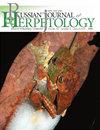Male and Female Cloacal Anatomy of the Fischer’s Clawed Salamander, Onychodactylus fischeri (Caudata, Hynobiidae)
IF 0.9
4区 生物学
Q3 ZOOLOGY
引用次数: 0
Abstract
The cloaca of salamanders is a complex organ with exocrine glands involved in the production of sex pheromones, spermatophores, and storage of sperm. Since the cloaca provides reproductive functions, its signs are important for phylogenetic analysis in the evolutionary biology of tailed amphibians. For clarification of intrafamilial variation of cloacal characteristics in hynobiids, we studied the anatomy of male and female cloacae of Onychodactylus fischeri via histological, histochemical, and 3D-reconstruction methods. Males and females had ciliated cloacal linings and with sexual dimorphism in cloacal conformation and cloacal glands. As in other males and females of hynobiids, females of O. fischeri possessed only ventral glands, secreting neutral glycoproteins. In contrast, males of this species had three types of the cloacal glands. Glands «B» were like ventral glands of females and other hynobiids, while glands «A» and «C» had different histochemical and morphological characteristics. As our results are generally consistent with the data for the related species O. japonicus, these characteristics of the male and female cloacal anatomy may be common to all species of the genus Onychodactylus. The presence of three types of unique cloacal glands in males distinguishes Onychodactylus from all other hynobiids and salamanders.费氏爪蝾螈的雌、雄泄殖腔解剖
蝾螈的泄殖腔是一个复杂的器官,其外分泌腺参与性信息素、精子载体和精子储存的产生。由于泄殖腔提供了繁殖功能,其标志对于尾两栖动物进化生物学中的系统发育分析很重要。为了阐明hynobids泄殖腔特征的家族内变异,我们通过组织学、组织化学和3D重建方法研究了金钱龙的雄性和雌性泄殖腔的解剖结构。雄性和雌性具有纤毛的泄殖腔衬里,在泄殖腔构象和泄殖腔腺方面具有两性异形。与其他海牛科的雄性和雌性一样,菲舍尔海牛的雌性只有腹侧腺体,分泌中性糖蛋白。相比之下,该物种的雄性有三种类型的泄殖腔腺。腺体“B”类似于雌性和其他hynobiids的腹侧腺体,而腺体“A”和“C”具有不同的组织化学和形态学特征。由于我们的研究结果与相关物种O.japonicus的数据基本一致,这些雄性和雌性泄殖腔解剖特征可能对所有种类的Onychodactylus都是共同的。在雄性动物身上存在三种独特的泄殖腔腺,这将Onychodactylus与所有其他hynobiids和蝾螈区别开来。
本文章由计算机程序翻译,如有差异,请以英文原文为准。
求助全文
约1分钟内获得全文
求助全文
来源期刊

Russian Journal of Herpetology
ZOOLOGY-
CiteScore
1.70
自引率
0.00%
发文量
29
期刊介绍:
Russian Journal of Herpetology is an international multi-disciplinary journal devoted to herpetology. Russian Journal of Herpetology accepts original papers on ecology, behavior, conservation, systematics, evolutionary morphology, paleontology, physiology, cytology and genetics of amphibians and reptiles.
Types of Contributions:
-original papers
-invited or contributed reviews on specific topics
-short communications on topics of immediate interest, new methods and ideas in progress
-notices of meetings, symposia, and short courses
-book reviews
 求助内容:
求助内容: 应助结果提醒方式:
应助结果提醒方式:


